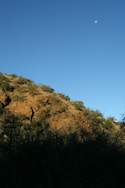A Mammoth Bolide

2 billion years ago, there was still no vegetation on the planet, and the only sign of life was bacterial. But, even so, things were about to get nasty.
A mammoth bolide had been drawn into Earth’s gravitational field and was accelerating down towards the planet’s surface. If the bacteria had legs, they would have run away!
We are not sure whether this bolide was an asteroid (a solid, rocky projectile) or a comet (with a core made of ice and rocks, trailing a tail of gas). Nor are we sure of how fast it was travelling, although it was probably in excess of 20 kilometers per second.
Judging by the extent of the crater it created, however, estimates on its size range between 5 and 15 kilometers across, depending on its projected speed, mass, density and angle of impact. This makes it significantly larger than Table Mountain!
It Hit Hard
As the bolide drew closer, the Earth held its breath…and then it hit. Hard! The point of impact was near the modern-day town of Vredefort, about 120 kilometers to the south-west of Johannesburg, and the consequences gave a new meaning to the term ‘catastrophic’.
When it struck, the kinetic energy of the projectile released the equivalent of 100 million megatons of dynamite – that’s 100 trillion tons of explosive force. By comparison, the most powerful nuclear bomb ever detonated only had a yield of 50 megatons. Within minutes, a total amount of 70 000 cubic kilometers of earth had been punched out of the ground and flung into the air, kicking up a huge cloud of dust that went into the atmosphere and blocked out the sun.
Rocky debris fell in a deadly rain that extended for hundreds of kilometers and winds gusted across the land, in excess of thousands of kilometers per hour. A crater more than 50 kilometers deep was gouged out of the land and the earth was turned inside out.
In addition to this primary chaos, the impact also caused landslides, earthquakes, fracturing of the crust and a variety of other natural disasters that were felt across the planet.
The Vredefort Dome
The steep walls of the initial crater collapsed quickly, however, and a shallow crater with a diameter of around 300 kilometers was formed in its stead. In the middle, a central uplift emerged when the heavily compressed ground rebounded into a dome-like feature, like the splash you make when you jump into a pool.
The Vredefort Dome had been created. A number of concentric, circular ridges also formed at regular intervals across the crater, like ripples in a petrified pond. Unbelievably, most of these monumental events took place within 15 minutes of the initial impact!
If there had been any kind of life on Earth, other than bacteria, it would have resulted in the mass extinction of many species.
Basically, it was the mother of all meteorite strikes – the biggest and the earliest impact event yet identified on the planet. So, let’s wait for the dust to settle and then step in for a closer look.
By David Fleminger